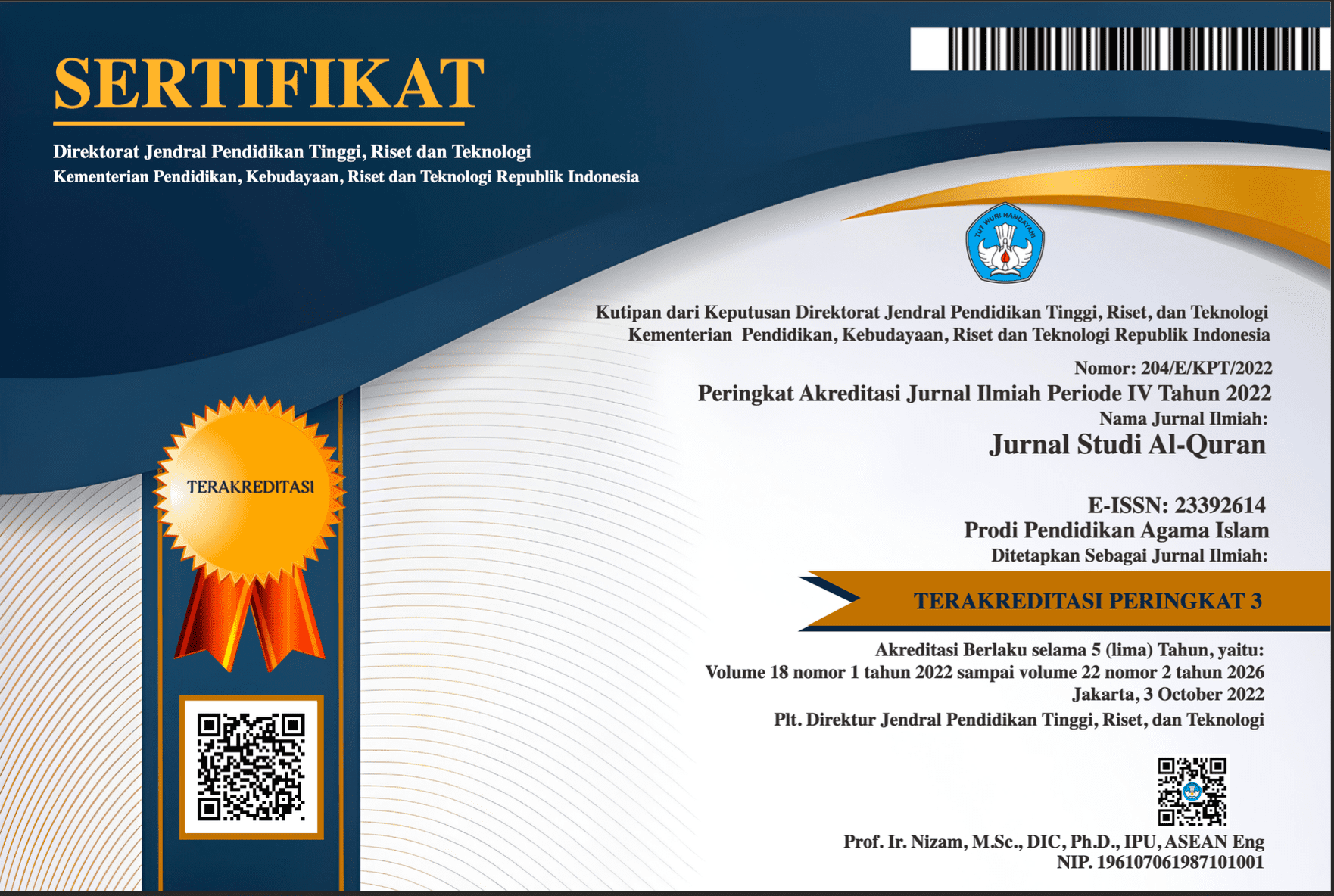Implementasi Metode Tahsin Al Husna dalam Pembelajaran Jarak Jauh pada Masa Pandemi Covid-19 di SDIT Al Kahfi
DOI:
https://doi.org/10.21009/JSQ.017.1.06Keywords:
Al Husna Tahsin Method, Qur’an Study, Distance LearningAbstract
This study aims to describe and analyze the implementation of the Al Husna method in learning tahsin at SDIT Al Kahfi Ciracas via distance learning mechanism. It seeks to answer the following questions, how was the preparation for distance learning tahsin Al-Quran using the Al Husna method, the implementation of distance learning tahsin Al-Quran using the Al Husna method, the evaluation of learning in distance learning tahsin using the Al Husna method. It also will describe the use of media in distance learning tahsin using the Al method Husna. This research used a descriptive analysis method using a qualitative approach, which was carried out from October to November 2020. Primary data collection took place at SDIT Al Kahfi Ciracas, East Jakarta. Data collection techniques include observation and interviews at SDIT Al Kahfi Ciracas, East Jakarta. Based on the results of observations and interviews conducted by researchers, distance learning Al-Quran tahsin using the Al Husna method at SDIT Al Kahfi, is implemented quite well. This can be seen from the stages in distance learning tahsin using the Al Husna method. Starting from the preparation and planning that is sufficiently well prepared with the administration of learning planning, preparation in terms of the capacity of teacher resources, as well as preparation of facilities and infrastructure to support distance learning. But, lesson planning design section was incomplete. Then, this study also shows that the implementation of tahsin distance learning using the Al Husna method was in accordance with the learning plan. Furthermore, it can also be seen from the evaluation of learning held in distance learning tahsin using the Al Husna method worked as expected.
References
Hartono, S. O. E. (2017). Penggunaan Metode Al-Husna untuk Peningkatan Kualitas Membaca Al-Qur’an dalam Program Pengenalan Al-Qur′an di SMP Muhammadiyah 8 Surakarta Tahun Ajaran 2016/2017. Universitas Muhammadiyah Surakarta.
Lilawati, A. (2020). Peran Orang Tua dalam Mendukung Kegiatan Pembelajaran di Rumah pada Masa Pandemi. Jurnal Obsesi, 5(1), 549–558.
Moleong, L. J. (2018). Metodologi Penelitian Kualitatif. Remaja Rosdakarya.
Santoso, Deri Teguh; Sari, R. P. (2020). Sosialisasi Penggunaan Aplikasi Video Conference Bagi Dosen Dan Mahasiswa Untuk Menunjang Pembelajaran Daring Di Masa Pandemic Covid-19. Universitas Muhammadiyah Mataram. http://journal.ummat.ac.id/index.php/jmm/article/view/3110
Setiawan, D. I. (2015). Pelaksanaan Kegiatan Tahsin Al-Qur’an dalam Meningkatkan Kemampuan Membaca Al-Qur’an Mahasiswa di Ma’had Sunan Ampel Al-Aly Universitas Negeri Maulana Malik Ibrahim Malang. Universitas Islam Negeri Maulana Malik Ibrahim Malang.
Supriadi, O. (2020). Peranan Kepala PAUD dalam Penyelenggaraan Pendidikan Sebelum dan Saat Terjadi Pandemi Covid-19. Jurnal Obsesi, 5(1), 841–856.
Wajdi, F., Fauzia, S., & Hakam, A. (2020). Evaluasi Program Tahfidz Melalui Media Sosial di Yayasan Indonesia Berkah. Jurnal Studi Al-Qur’an , 16(1 SE-Articles). https://doi.org/10.21009/JSQ.016.1.05
Widyaningrum, G. L. (2020). WHO Tetapkan COVID-19 Sebagai Pandemi Global, Apa Maksudnya? Nationalgeographic. https://nationalgeographic.grid.id/read/132059249/who-tetapkan-covid-19-sebagai-pandemi-global-apa-maksudnya
Downloads
Published
How to Cite
Issue
Section
License
Authors who publish with this Journal agree to the following terms:
- Author retain copyright and grant the journal right of first publication with the work simultaneously licensed under a creative commons attribution licensethat allow others to share the work within an acknowledgement of the work’s authorship and initial publication of this journal.
- Authors are able to enter into separate, additional contractual arrangementfor the non-exclusive distribution of the journal’s published version of the work (e.g. acknowledgement of its initial publication in this journal).
- Authors are permitted and encouraged to post their work online(e.g. in institutional repositories or on their websites) prior to and during the submission process, as it can lead to productive exchanges, as well as earlier and greater citation of published works.
Users/public use of this website will be licensed to CC BY










